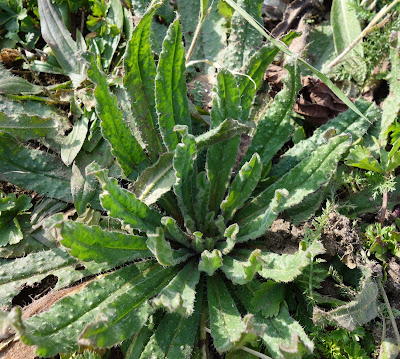 |
| About 12 different species are visible in this picture |
Spring still has not arrived yet and the plants in our perennial flower meadows show no signs of flowering yet. But even if they have no flowers at the moment you can still tell the different species apart from each other if you look at other characteristics such as leave shape, hairiness and venation of the leaves as well as the growing habit. Once you get your eye in you will be amazed how many different species you spot when everything looked just like lots of green leaves before.
Below I have made a list of common (and some less common but worth finding) perennial meadow plant species and how they look like at the moment. I also give some clues of what to look for to identify the plant species. You can practice your plant identification skills in our perennial project meadows which you can find in Reading, Leeds, Edinburgh and Bristol (http://www.bristol.ac.uk/biology/research/ecological/community/pollinators/urbanmeadows/flowermeadows.html) or just have a look in your local area if you can find a suitable patch with a diverse mix of perennial meadow plants. If you encounter a species you do not recognise take a photo and memorise (or mark) the spot were you found the plant and come back in June or July and have a look if the plant is in flower. Plants are much easier to identify once they are in flower and most plant identification books use flower features to tell species apart.
Yarrow (Achillea millefolium)
Yarrow is quite easy to recognise as it has long, narrow very deeply divided leaves which are further divided into many deeply divided lateral lobes (the second part of the scientific name, millefolium, means thousand leaves). In some of our meadows it is quite abundant and easy to find.
Ox-eye daisy (Leucanthemum vulgare)
Ox-eye daisy grows in clumps and has rounded serrated often dark green leaves which are abruptly contracted at the leave base (which often has a reddish colour). Abundant in most of our meadows.
Wild carrot (Daucus carota)
Wild carrot is a biennial plant and grows as a rosette with long pinnate leaves in its first year before it flowers in the second year. The root has a strong characteristic carrot smell. Wild carrot looks similar to the cultivated carrot so if you grow carrots in your garden or on your allotment you will probably have no trouble identifying this plant.Wild carot is quite frequent in most of our meadows.
Ribwort plantain (Plantago lanceolata)
 |
| Plantago lanceolata on the right, Leucanthemum vulgare on the left |
Ribwort plantain grows as one to several rosettes and has linear, slightly hairy entire to sparsely and weakly toothed leaves. The leaves have a characteristic linear venation. It is quite common in most of our meadows.
Black knapweed (Centaurea nigra)
Black knapweed is an erect perennial and has greyish, hairy, elongated and mostly entire leaves. It is not as common as the species mentioned above but still quite easy to find in most of our meadows.
Field scabious (Knautia arvensis)
Musk mallow (Malva moschata)
Rough hawkbit (Leontodon hispidus)
Rough hawkbit forms clumps and has hairy deeply lobed leaves similar to dandelion (Taraxacum officinalis agg) leaves (but dandelion leaves are never this hairy!). The leaves feel quite rough when handled, hence the common name. It is fairly common in most of our meadows but take care not to confuse it with dandelion.
Wild marjoram (Origanum vulgare)
Wild marjoram has small rounded slightly hairy leaves, dark green in colour often with a reddish tinge. If the leaves are bruised they release the typical oregano smell you are probably familiar with if you like pizza and other Mediterranean dishes. It is not very common in our meadows but with a bit of searching you can probably find it in many of them.
Viper`s bugloss (Echium vulgare)
Lady`s bedstraw (Galium verum)
Cowslip (Primula veris)
Look here for a complete species list of the seed mix we used for our meadows, but be aware that not all species have germinated yet: http://wildseed.co.uk/mixtures/view/62
Also have a look at part 2 of "How to recognise perennial meadow plant species when they are not in flower": http://urbanpollinators.blogspot.co.uk/2013/04/how-to-recognise-perennial-meadow-plant.html
If you want to try your hands at advanced identification of plants using vegetative characteristics you can have a look at the following book:
The Vegetative Key to the British Flora by John Poland & Eric Clement, ISBN 13: 978-0-9560144-0-5











Thanks for this Nadine - I think I may have to print it out and use it this summer! :)
ReplyDeleteI hope it will help :-). I am planning to do a part 2 for this, just need to do some more pictures of different species when I am visiting the meadows the next time.
DeleteGreat article - looking forward to part 2
ReplyDeleteLove this!
ReplyDeleteThis is so good I have just taken over part of a field and am identifying the species in it I have Vipers Bugloss all over the place and I love it!
ReplyDelete